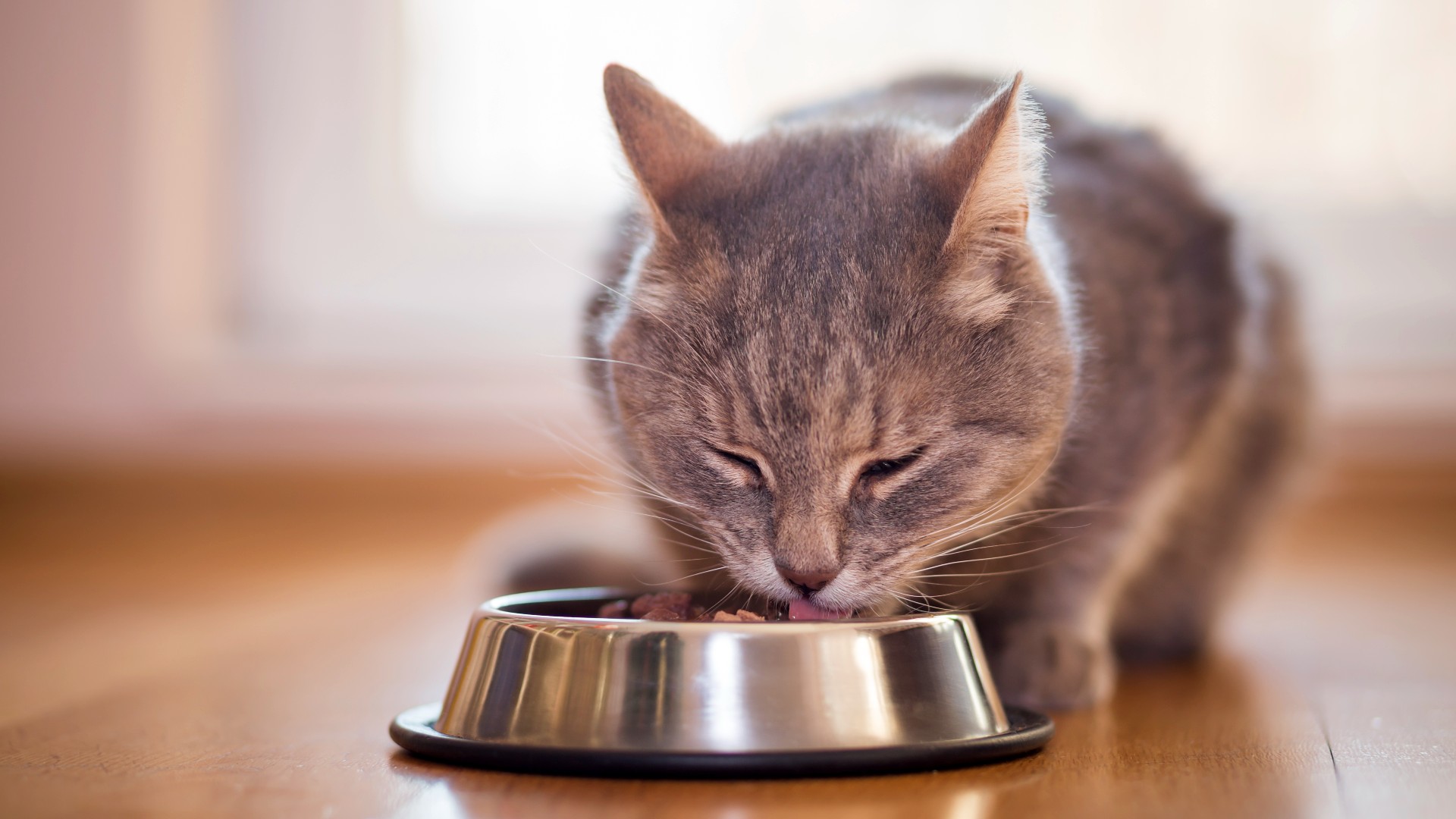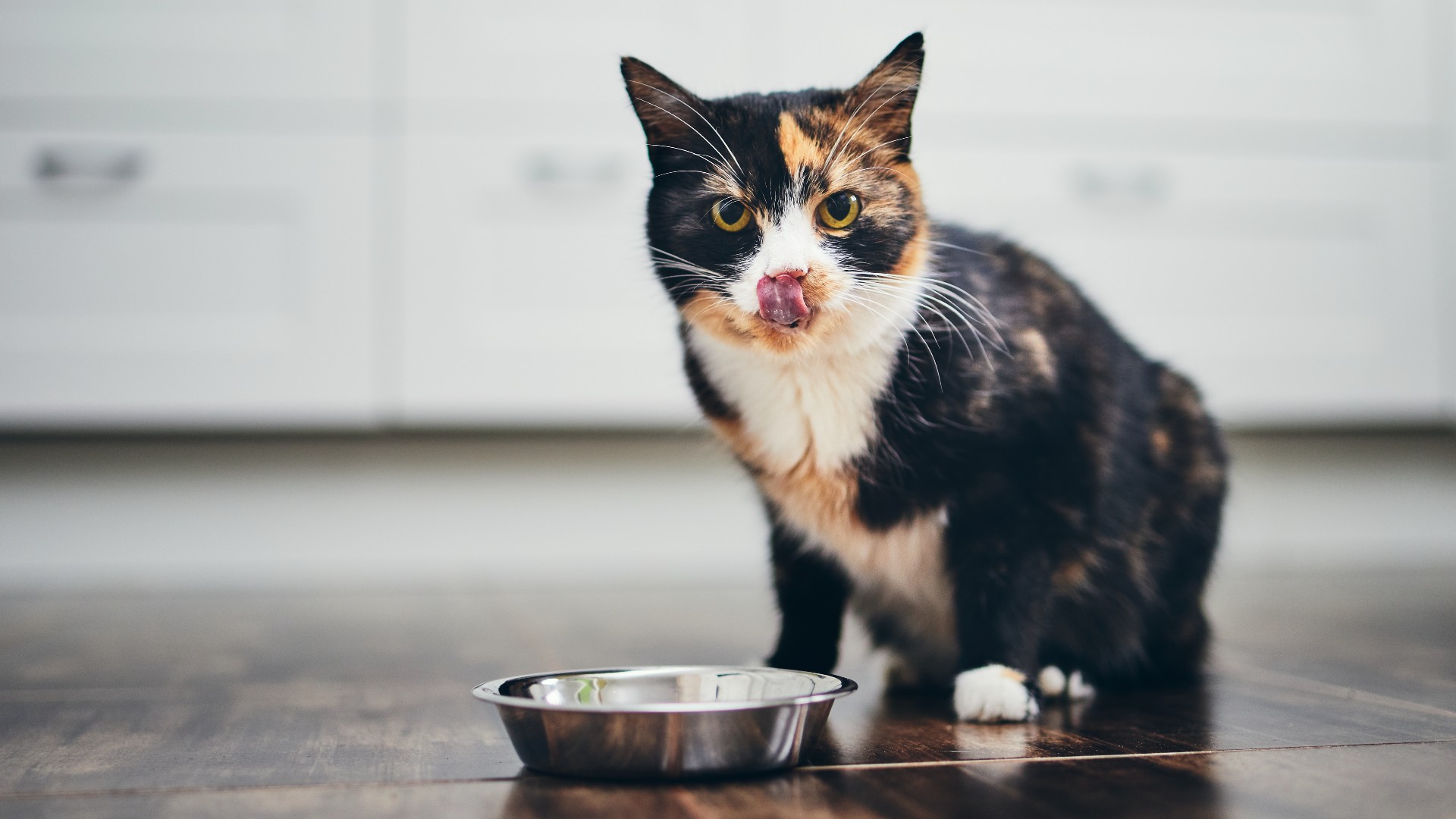5 benefits of timed feeding for cats and how to transition
Timed feeding for cats offers a host of benefits from keeping their weight in check to observing changes in eating habits - here's how to make the switch

Timed feeding for cats is becoming more and more popular amongst pet parents who are looking for new ways to keep their feline furkid happy and healthy. While free feeding has its own share of perks, there are a lot of benefits to timed feeding that make it well worth considering.
But before we look at those, it can be good to understand what it is we mean by free feeding vs timed feeding. Free feeding is when you allow your kitty to graze whenever they want throughout the day. While giving your furball access to the best cat food 24/7 does allow them to eat on their own schedule, the downside is that it can also lead to overeating and obesity.
Timed feeding, also known as meal feeding, is when you decide on two to three set feeding times and only dish out the best dry cat food or the best wet cat food at those specific times, removing your feline friend's food bowl after they’ve finished so that they know mealtime is over.
When you think about it, timed feeding for cats is pretty much in line with the way most of us humans eat, so you’re not in any way depriving them - your kitty will still get all the nutrients they need in their two scheduled meals to ensure they thrive. In fact, far from being disadvantageous, timed feeding has been proven to be hugely beneficial.
Below, we walk you through all the benefits of time feeding, so that you can see exactly how making the switch can help both you and your feline friend. Plus, we show you how to make the transition gently and safely to give your kitty cat the best chance of adapting to their new food regime.
- Five ways to improve your cat’s diet
- 8 human foods that are poisonous to cats: What to avoid
- 11 things to check when your cat’s not eating: Advice from a vet
The benefits of timed feeding for cats
First things first - when you take free feeding off the table and replace it with timed feeding, it’s likely your cat will protest. After all, if they’re going from having access to an endless buffet to two meals a day, expect them to be vocal about it!
But, stay firm, and your feline friend will soon adjust, which is good news as timed feeding offers a host of benefits to both them and you that you just can’t get with free feeding. Let’s take a look at each of these:
1. Portion control
The most obvious benefit to timed feeding is that it allows you to control the portions of food that your feline friend is consuming. With free feeding, you always run the risk that your cat will eat too much throughout the day and end up putting on weight, but with timed feeding, you can control their intake.
A cat's stomach operates in much the same way as a human one, emptying within a few hours as the food moves into the small intestine, so by around the 10 hour mark, your kitty will be feeling pretty ravenous and ready for their next meal.
For that reason, we recommend feeding your cat either twice or three times a day, depending on which option best suits your schedule. If you’re out of the house a lot, don’t fret, investing in one of the best automatic pet feeders will ensure your kitty always gets their food on time.
2. Lets you observe your cat’s eating habits
Timed feeding is a wonderful way to keep an eye on your cat’s eating habits as it allows you to quickly catch any changes in food intake or eating behaviors. If your cat is suddenly not eating their food or is consuming much less than they normally would, this could be a sign of illness.
Spotting this change early on means you can get your feline friend checked out by their vet and if they get the all clear, it could be a simple case of your little one not liking the food you’re dishing up - either way, early observation of a change in eating habits can help you seek the right solution.
3. Creates a routine for your kitty
Cats are notorious creatures of habit, so timed feeding actually works beautifully for them. Use this natural instinct to your advantage by creating regular set meal times and you’ll find your kitty thrives on the predictability and security that timed meals offer them.
While this predictability and security is useful for cats all of the time, it can come in particularly handy when there are changes going on in their environment that they might be finding stressful, such as a new addition to the family. Knowing when they’re going to get fed can help soothe their anxiety and offer much needed comfort.
4. Makes it easier to give medication
Is your cat currently taking any medication? If so, timed feeding can really help you out. Unlike free feeding, where you may forget to give your cat their medication or be unclear if they’ve actually eaten it, timed feeding lets you slip their tablet or paste into their food and watch them to make sure they’ve consumed it.
5. Prevents domination in multi-cat households
Finally, if you have more than one feline furball running around your home, timed feeding can be a great way of ensuring one cat isn’t dominating the other and eating two portions of food instead of one!
Mealtime dominance is not unusual in multi-cat homes because usually one kitty tends to hold the status of ‘top cat’ while the other one will tend to be more submissive. Even if your cats are total besties, you may find one is a faster eater who then tries to gobble up the rest of the slower eater's meal.
Timed feeding allows you to keep an eye on both your cats to make sure they’re getting the nutrition they need. If you’re not able to stand nearby and monitor them at mealtimes, try feeding them in different locations to ensure each kitty gets their full portion of food.
How to transition your cat onto timed feeding

If, after reading all of these exciting benefits, you’ve decided that timed feeding is definitely the way you want to go, it’s important to transition your cat slowly. Just like you need to give your kitty time to adjust when you’re changing cat food, changing how often your feline furkid eats also requires a slow approach.
When you’re making the switch, considering the time you’ll feed your cat, the place they’ll eat, their portion sizes and how you’ll let them know it’s mealtime, are all key things to think through. Here’s a few tips to help you transition your cat easily:
1. Set a time
The first thing you want to do is decide on which two (or three) times of the day you plan on feeding your cat. Depending on your own schedule, you might opt for 7am, 1pm, and 7pm if you’re going for three meals a day or 8am and 5pm if you’re feeding twice a day.
The times themselves don’t matter, what is important is consistency - make sure that once you’ve set the times that you stick to them as closely as possible every day so that your cat knows what to expect.
In the beginning, you may need to feed them eight small meals staggered across the day, so that they get used to not being able to free feed. If you don’t work from home and this isn’t possible, try leaving out a small amount of kibble that they can snack on in between their meals and slowly reduce this until they’re eating their main meals only.
2. Designate a place
You want to keep things consistent across the board, so choose a place that you’re going to feed your cat each day and be sure to put their bowl down in the same place at every mealtime. We recommend you pick a new spot and not an old one that they associate with their free feeding days.
3. Create a signal
Designate a ‘call’ signal that you can use to alert your feline friend to the fact that it’s time to eat. This could be a particular word or sound that your cat will come to associate with mealtimes.
4. Make sure you get the portion size right
To ensure you’re feeding your cat the right amount of food each day, ensure you consult the label on the tin or bag of cat food that you’ve purchased. This should contain a chart that provides recommended daily feeding guidelines based on a cat's body weight.
Once you know how much your cat needs to eat each day to get all the vital nutrients they need, split this into two or three meals, depending on how often you’re wanting to feed them. We recommend you use a measuring cup for dry food to make sure the portion is accurate and use the tin as a guide if you’re serving up wet food.
For more information on portion sizes, check out our vets answer to the question ‘how much should I feed my cat?’ You might also find it helpful to cast your eyes over our top tips for feeding a cat properly to give yourself the peace of mind that you’re ticking all the right boxes.
For more great nutritional content and advice, be sure to check out our guide to cat won’t eat dry food for tips on what to do if your kitty refuses to eat their kibble.
PetsRadar Newsletter
Get the best advice, tips and top tech for your beloved Pets

Kathryn is a freelance writer who has been a member of the PetsRadar family since it launched in 2020. Highly experienced in her field, she's driven by a desire to provide pet parents with accurate, timely, and informative content that enables them to provide their fur friends with everything they need to thrive. Kathryn works closely with vets and trainers to ensure all articles offer the most up-to-date information across a range of pet-related fields, from insights into health and behavior issues to tips on products and training. When she’s not busy crafting the perfect sentence for her features, buying guides and news pieces, she can be found hanging out with her family (which includes one super sassy cat), drinking copious amounts of Jasmine tea and reading all the books.
